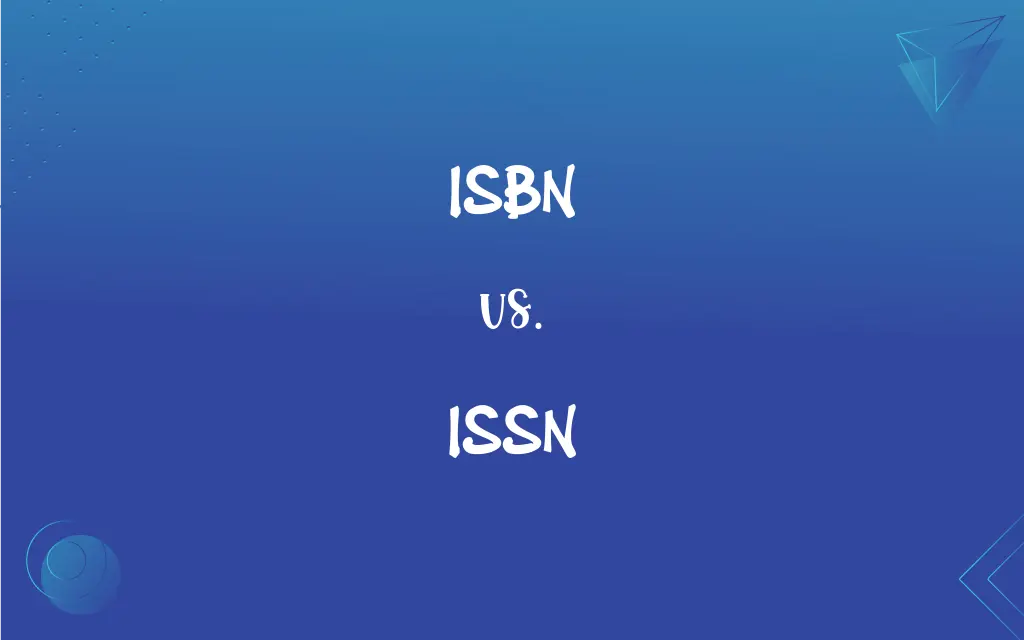ISBN vs. ISSN: What's the Difference?
Edited by Aimie Carlson || By Janet White || Published on February 27, 2024
ISBN (International Standard Book Number) is a unique identifier for books, while ISSN (International Standard Serial Number) is used to identify periodical publications like journals and magazines.

Key Differences
ISBN is a unique numerical identifier for books, allowing easier distribution and sale in the global market. ISSN, on the other hand, identifies serial publications, such as journals, magazines, and newspapers, aiding in their cataloging and distribution.
An ISBN is a 13-digit code (formerly 10 digits) that includes elements identifying the book’s country, publisher, and title. ISSN consists of an 8-digit code, designed to identify a specific serial publication, regardless of language or country.
Each edition and variation of a book (e.g., paperback, hardcover, ebook) receives its own ISBN, ensuring precise identification. An ISSN is assigned to the entire serial, not to individual issues or editions, providing a constant identifier for the publication as a whole.
ISBNs are crucial in the library and retail sector for cataloging books, managing inventory, and facilitating sales. ISSNs are used by libraries and database systems to track serials and manage their collections effectively.
Both ISBN and ISSN are international standards, with ISBNs administered by the International ISBN Agency and individual national agencies, and ISSNs by the International Centre for the Registration of Serial Publications.
ADVERTISEMENT
Comparison Chart
Full Form
International Standard Book Number
International Standard Serial Number
Purpose
Identifies individual books
Identifies serial publications
Code Length
13 digits (formerly 10)
8 digits
Specificity
Unique to each edition and format of a book
Unique to a serial publication as a whole
Usage
Libraries, book retailers, publishers
Libraries, serial publishers, databases
ADVERTISEMENT
ISBN and ISSN Definitions
ISBN
Each variation of a book gets its own ISBN.
The eBook version has a separate ISBN from the print version.
ISSN
ISSN is used for cataloging periodicals in libraries.
Librarians use the ISSN to manage magazine subscriptions.
ISBN
ISBN facilitates global book distribution.
International book sales are streamlined by using ISBN.
ISSN
ISSNs are 8 digits long, identifying a publication regardless of language or country.
The journal's ISSN is internationally recognized.
ISBN
ISBN aids in book cataloging and sales.
The bookstore orders books using their ISBN.
ISSN
ISSN aids in the tracking and ordering of serials.
The library database uses ISSN for serial inventory.
ISBN
ISBN uniquely identifies a book's edition and format.
The hardcover and paperback versions have different ISBNs.
ISSN
ISSN applies to the whole serial publication, not individual issues.
Each issue of the journal has the same ISSN.
ISBN
ISBNs are 13 digits long, containing specific publisher and title information.
The ISBN indicates the book’s publisher and geographic location.
ISSN
ISSN is a unique code for identifying serial publications.
The magazine's ISSN remains the same for all its issues.
FAQs
Who uses ISBN?
ISBN is used by publishers, booksellers, libraries, and distributors.
Who uses ISSN?
ISSN is used by publishers of serials, libraries, and information services.
What does ISSN stand for?
ISSN stands for International Standard Serial Number.
How long is an ISSN?
An ISSN is 8 digits long.
How long is an ISBN?
An ISBN is 13 digits long.
Does an eBook need an ISBN?
Yes, eBooks typically require their own ISBN.
Does each issue of a magazine have a different ISSN?
No, all issues of the same magazine share the same ISSN.
Is ISBN used internationally?
Yes, ISBN is a global standard.
What does ISBN stand for?
ISBN stands for International Standard Book Number.
Can two books have the same ISBN?
No, each book and edition has a unique ISBN.
Where is the ISBN located on a book?
The ISBN is usually found on the back cover or the title page.
Is ISSN used internationally?
Yes, ISSN is used internationally.
Do old books have ISBN?
Books published before 1970 may not have an ISBN.
How is an ISBN obtained?
Publishers obtain ISBNs from the national ISBN agency.
Does an ISBN change with a new edition?
Yes, new editions of a book require a new ISBN.
Can a serial and a book have the same ISSN/ISBN?
No, ISBNs and ISSNs are exclusive to their respective publication types.
Where is the ISSN located on a magazine?
The ISSN is typically found on the front or back cover, or the masthead.
Do all magazines have an ISSN?
Most serial publications have an ISSN, but it's not mandatory.
How is an ISSN obtained?
Publishers apply for an ISSN through the ISSN International Centre.
Does an ISSN change with a new title?
Yes, if a serial publication changes its title, it typically gets a new ISSN.
About Author
Written by
Janet WhiteJanet White has been an esteemed writer and blogger for Difference Wiki. Holding a Master's degree in Science and Medical Journalism from the prestigious Boston University, she has consistently demonstrated her expertise and passion for her field. When she's not immersed in her work, Janet relishes her time exercising, delving into a good book, and cherishing moments with friends and family.
Edited by
Aimie CarlsonAimie Carlson, holding a master's degree in English literature, is a fervent English language enthusiast. She lends her writing talents to Difference Wiki, a prominent website that specializes in comparisons, offering readers insightful analyses that both captivate and inform.































































